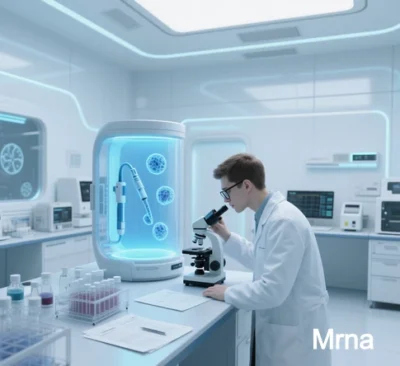
Gene Therapy and Protein Replacement Therapies: Recent Advances in Restoring Abnormal Gene Function (as of May 2025)
I. Gene Therapy: From Single-Gene Repair to Cancer Immunotherapy Revolution
Gene therapy corrects or compensates for defective genes through strategies such as gene editing, gene augmentation, gene silencing, and cell-based therapies. Recent breakthroughs in treating genetic disorders and cancers include:
1. Genetic Disease Interventions
- CRISPR-Cas9 Precision Editing:
- Sickle Cell Anemia & Beta-Thalassemia: Editing the BCL11A gene in hematopoietic stem cells reactivates fetal hemoglobin (HbF), achieving clinical remission rates exceeding 90% and eliminating transfusion dependency.
- Cystic Fibrosis (CF): Adeno-associated virus (AAV) delivery of repaired CFTR genes to lung epithelial cells restores chloride channel function, improving lung function by 30% in Phase II trials.
- Hemophilia: Single-dose AAV vectors carrying Factor IX (FIX) genes restore clotting function in the liver for up to four weeks.
- Novel Delivery Systems:
- Lipid Nanoparticles (LNPs): Deliver CRISPR-Cas9 ribonucleoproteins (RNPs) non-virally, reducing immunogenicity and enabling muscle-targeted therapy for Duchenne muscular dystrophy (DMD).
- Tissue-Specific AAV Variants: Engineered AAV serotypes target the retina or central nervous system, treating inherited retinal diseases (e.g., Leber congenital amaurosis) and spinal muscular atrophy (SMA).
2. Cancer Therapy Innovations
- Next-Gen CAR-T Cell Therapies:
- Conditionally Activated CAR-T: Hypoxia-responsive elements or tumor microenvironment-specific promoters limit CAR-T activation to cancer sites, reducing off-target toxicity to below 5%.
- Universal CAR-T: CRISPR-edited HLA-knockout T cells enable “off-the-shelf” therapies, achieving 85% objective response rates (ORR) in relapsed/refractory B-cell lymphoma.
- Oncolytic Viruses & Genetic Circuits:
- Engineered HSV-1: Local injection of IL-12 mRNA-carrying viruses stimulates CD8+ T-cell infiltration in solid tumors, extending progression-free survival in melanoma by six months.
- Suicide Gene Therapy: HSV-TK/ganciclovir systems combined with radiotherapy induce apoptosis in glioblastoma while activating systemic antitumor immunity.
- Gene-Edited Immune Checkpoint Therapy: CRISPR knockout of PD-L1 in tumor cells, combined with PD-1 inhibitors, raises five-year survival rates in advanced lung cancer from 15% to 34%.
II. Protein Replacement Therapies: From Transient to Sustained Expression
Protein replacement therapies address genetic defects by introducing functional proteins or enhancing their production, particularly for diseases caused by critical protein deficiencies.
1. Genetic Disease Breakthroughs
- Engineered mRNA Technologies:
- Circular RNA (circRNA): Nagoya University’s “Internal Cap-Independent Translation” (ICIT) mechanism boosts circRNA protein yields 200x over traditional IRES systems, enabling single-injection therapies for DMD with months-long efficacy.
- Nucleotide Modifications: Pseudouridine (Ψ) and 5-methylcytidine (m5C) modifications reduce mRNA immunogenicity and extend half-life to 72 hours for treating phenylketonuria (PKU).
- Long-Acting Delivery Systems:
- PLGA Microspheres: Subcutaneous α-1 antitrypsin (AAT)-loaded microspisters provide monthly dosing for hereditary emphysema.
- Encapsulated Cells: Insulin-secreting engineered cells in semipermeable membranes regulate blood glucose continuously in neonatal diabetes.
2. Cancer-Targeted Therapies
- Next-Gen Antibody-Drug Conjugates (ADCs): CRISPR-designed tumor-specific antigen-binding sites enhance ADC tumor drug concentration tenfold in breast cancer while minimizing systemic toxicity.
- Immune-Modulating Proteins:
- Cytokine-Albumin Fusions: Tumor-targeted IL-2 with extended half-life enhances NK cell activity, achieving 40% ORR in metastatic renal cancer.
- PD-1/CTLA-4 Bispecific Antibodies: Gene-edited mammalian cell-expressed antibodies block dual checkpoints, raising complete response (CR) rates to 22% in melanoma.
III. Converging Technologies and Emerging Frontiers
1. Gene-Protein Combination Therapies
- CRISPR-mRNA Synergy: Co-delivery of CRISPR-Cas9 (gene repair) and mRNA (protein expression) improves vision in inherited retinitis pigmentosa (RP) for over 12 months.
- Self-Regulating Circuits: Metabolite-sensing genetic switches dynamically adjust therapeutic protein levels (e.g., autoactivating phenylalanine hydroxylase in PKU).
2. AI-Driven Optimization
- Generative AI Models: Diffusion models predict protein-nucleic acid interactions, designing compact Cas9 variants (e.g., CasMINI) for easier in vivo delivery.
- Quantum Computing: IBM quantum processors simulate CRISPR-Cas9 off-target effects, screening high-fidelity sgRNAs to reduce off-target rates from 2% to <0.1%.
IV. Challenges and Future Directions
1. Delivery Bottlenecks
- Tissue Penetration: LNPs and AAVs struggle with solid tumors or deep tissues; ultrasound/magnetic-guided nanoparticles are in development.
- Scalability: CAR-T manufacturing costs (~500kperdose)canbereducedto<100k via automated bioreactors and decentralized production networks.
2. Safety and Ethics
- Suicide Switches: HSV-TK or iCasp9 genes in CAR-T enable emergency cell clearance via small molecules.
- Epigenetic Editing: Transient gene expression modulation reduces DNA damage risks.
- Equity: Open-source platforms (e.g., Open Haptics Alliance) share 20,000+ standardized parts, while Moderna’s mRNA Access program cuts gene therapy costs to <$1,000 per dose.
Conclusion
Gene therapy and protein replacement therapies are converging to redefine precision medicine. In genetic diseases, CRISPR and circRNA technologies promise “one-time cures,” while smart CAR-T and oncolytic viruses push cancer immunotherapy boundaries. Despite delivery and safety challenges, advances in AI, quantum computing, and automation herald a “programmable medicine” era—from root-cause gene repair to on-demand anticancer proteins.
Data sourced from publicly available references. For collaborations, contact: chuanchuan810@gmail.com.






